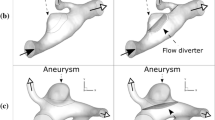Abstract
In recent years, intracranial thrombectomy stent has been an important method to treat ischemic stroke caused by acute thrombosis. In this paper, a new intracranial thrombectomy stent with a fish scale-like structure was designed and its mechanical properties were studied by a finite element method. The porosity of all stents was more than 80%. The space occupation ratio (SOR) of the stents increased linearly with the increase of strut thickness, while the strut width had little effect on SOR. The maximum equivalent stress and strain, the directional deformation and overall radial load of the stent decreased with the increase of strut thickness, however, the strut width has little impact on these parameters. The stents with 0.2 mm strut width and the thickness of 0.15 and 0.20 mm had better radial load performance, and the stent with 0.2 mm strut width and 0.15 mm strut thickness had better contact performance with the vessel wall and displayed better flexibility. Therefore, the present study provides a theoretical basis for the design of new intracranial thrombectomy stent.










Similar content being viewed by others
References
J. Jiang, Y. Wang, B. Liu, X. Chen, and S. Zhang: Challenges and research progress of the use of mesenchymal stem cells in the treatment of ischemic stroke. Brain Dev. 40, 612–626 (2018).
R. Howard: The management of ischaemic stroke. Anaesth. Intens. Care Med. 17, 591–595 (2016).
M.L. Bussmann, H.P. Neunzig, J. Gerber, J. Steinmetz, S. Jung, and R. Deck: Effects and quality of stroke rehabilitation of BAR phase D. Neurol. Int. Open 2, E16–E24 (2018).
C. Zerna, J. Hegedus, and M.D. Hill: Evolving treatments for acute ischemic stroke. Circ. Res. 118, 1425–1442 (2016).
M.J. Alberts, T. Shang, and A. Magadan: Endovascular therapy for acute ischemic stroke. JAMA Neurol. 72, 1101–1103 (2015).
J. Pagola, C. Molina, M. Ribo, C. Wijman, and W. Schonewille: Recanalization and outcome after intravenous thrombolysis in acute basilar artery occlusion in the Basilar Artery International Cooperation Study (BASICS): Does location of occlusion matter? Stroke 41, e332 (2014).
H. Janssen, H. Brückmann, M. Killer, S. Heck, G. Buchholz, and J. Lutz: Acute basilar thrombosis: Recanalization following intravenous thrombolysis is dependent on thrombus length. PLoS ONE 13, e0193051 (2018).
J.L. Saver, M. Goyal, A. Bonafe, H.C. Diener, E.I. Levy, V.M. Pereira, G.W. Albers, C. Cognard, D.J. Cohen, W. Hacke, O. Jansen, T.G. Jovin, H.P. Mattle, R.G. Nogueira, A.H. Siddiqui, D.R. Yavagal, B.W. Baxter, T.G. Devlin, D.K. Lopes, V.K. Reddy, R.M. de Rochemont, O.C. Singer, and R. Jahan: Stent-retriever thrombectomy after intravenous t-PA vs. t-PA alone in stroke. N. Engl. J. Med. 372, 2285–2295 (2015).
A. Ramana, C. Zerna, B.K. Menon, and M. Goyal: Endovascular interventions in acute ischemic stroke: Recent evidence, current challenges, and future prospects. Curr. Atheroscler. Rep. 18, 40 (2016).
H.S. Futch, B.M. Corliss, A.J. Polifka, B.L. Holt, and W.C. Fox: Solitaire stent retriever mechanical thrombectomy in a 6-month-old patient with acute occlusion of the internal carotid artery terminus: Case report. World Neurosurg. 126, 631–637 (2019).
S. Soize, K. Kadziolka, L. Estrade, I. Serre, S. Bakchine, and L. Pierot: Mechanical thrombectomy in acute stroke: Prospective pilot trial of the Solitaire FR device while under conscious sedation. Am. J. Neuroradiol. 34, 360–365 (2013).
Z. Kulcsar, C. Bonvin, K.O. Lovblad, B. Gory, H. Yilmaz, R. Sztajzel, and D. Rufenacht: Use of the Enterprise™ intracranial stent for revascularization of large vessel occlusions in acute stroke. Clin. Neuroradiol. 20, 54–60 (2010).
D. Ding, D.M. Raper, A.J. Carswell, and K.C. Liu: Endovascular stenting for treatment of mycotic intracranial aneurysms. J. Clin. Neurosci. 21, 1163–1168 (2014).
L. Zhou, Y. Ren and H. Liang: Clinical analysis of 8 cases of acute ischemic stroke treated with TREVO stent thrombectomy. J. Clin. Res. 34, 533–536 (2017).
A.P. Summers: Fast fish. Nature 429, 31–33 (2004).
W. Yang, I.H. Chen, B. Gludovatz, E.A. Zimmermann, R.O. Ritchie, and M.A. Meyers: Natural flexible dermal armor. Adv. Mater. 25, 31–48 (2013).
A.Y.S. Tang, H.N. Chan, A.C.O. Tsang, G.K.K. Leung, K.M. Leung, A.C.H. Yu, and K.W. Chow: The effects of stent porosity on the endovascular treatment of intracranial aneurysms located near a bifurcation. J. Biomed. Sci. Eng. 6, 812–822 (2013).
A. García, E. Peña and M.A. Martínez: Influence of geometrical parameters on radial force during self-expanding stent deployment. Application for a variable radial stiffness stent. J. Mech. Behav. Biomed. Mater. 10, 166–175 (2012).
A. Qiao and K. Zeng: Numerical simulation of hemodynamics in intracranial saccular aneurysm treated with a novel stent. Neurol. Res. 35, 701–708 (2013).
Y.C. Chuang and Y.C. Fung: Compressibility and constitutive equation of arterial-wall in radial compression experiments. J. Biomech. 17, 35–40 (1984).
Acknowledgments
The authors thank the financial supports from the Natural Science Foundation of China (31870952), the Natural Science Foundation of Jiangsu Province of China (BK20181480), Qinglan Projects of Jiangsu Province of China (2018), and the Key Program for Natural Science Foundation of the Jiangsu Higher Education Institutions of China (17KJA530002).
Author information
Authors and Affiliations
Corresponding authors
Rights and permissions
About this article
Cite this article
Zhao, F., Yang, Y., Zhao, Y. et al. Design and mechanical properties simulation of fish scale-like intracranial thrombectomy stent. Journal of Materials Research 35, 2416–2426 (2020). https://doi.org/10.1557/jmr.2020.169
Received:
Accepted:
Published:
Issue Date:
DOI: https://doi.org/10.1557/jmr.2020.169




